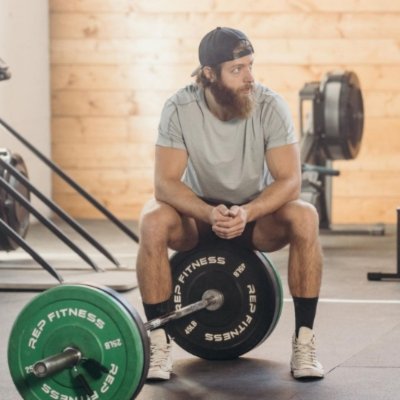The Kelso shrug is an underrated exercise for building and strengthening the traps. It wasn’t until recently that I started programming the Kelso shrug again and it has me wondering why I haven’t been doing more of them.
I’ve found the Kelso shrug to be best for building the thickness of the traps, especially the upper and mid traps. This variation is a little more complex with its setup, but it’s worth it if you have the equipment.
Below, I’ll explain how to perform a Kelso shrug and set them up properly, cover some benefits of this exercise, and share thoughts on programming them.
Kelso Shrugs Facts
- Experience Level: Beginner to Advanced
- Equipment Needed: Incline Bench, Plates, and Smith Machine
- Primary Muscles Worked: Traps
- Secondary Muscles Worked: Rear Delts
How To Do Kelso Shrugs
Step 1: Nail your setup
Getting quality Kelso shrug reps is all about your setup. If you can properly align your bench and Smith machine, you’ll get the most out of this exercise.
You’ll need to grab an incline bench and bring it to your gym’s Smith machine. Set your incline at about 45 degrees, if not a little higher. I always suggest playing with your bench setup slightly to see what “feels” best when you’re doing reps.
Ideally, you want the Smith machine’s bar to be sitting over the end of the bench where the wheels are. This will usually be the sweet spot for allowing you to get the most out of the shrug range of motion.
You’ll position the pecs at the top of the bench so that when you’re grabbing the Smith machine you somewhat fold over the bench. There’s a happy medium here that you’ll want to approach.
Step 2: Establish your grip and brace
For the Kelso shrug, I like to use a snatch-style grip. This usually is in between my traditional deadlift grip and my snatch grip. Your grip width should reflect your anatomy AKA your arm length and torso width.
If you have a wider torso then you may want to grip wider and if you’re thinner then you’ll likely find a narrower or more “traditional” grip a little more comfortable than going super wide like your normal snatch grip.
Step 3: Keep the arms long and shrug
Once you’ve established your grip, you’ll want to think about keeping your arms long. This means that you’re not flexing the elbows and arms when shrugging your Kelso shrug reps.
Like traditional shrugs, you don’t want to do “too much” and you want your traps to be doing the brunt of the work. The range of motion that the traps will move through is smaller than you think so it’s important to not fall into the “more is more” trap.
Think about shrugging in an upward fashion as if you’re trying to lift the bar following the Smith machine’s bar path. The Smith machine is great because it will keep your resistance line consistent.
Move slowly through your reps and focus on trying to only initiate your movement with the traps. If you notice you’re bending the arms a ton, either drop the weight or slow down as this can help you “feel” your reps better.
Need help building your traps? Check out my coaching app TF2 Strength. I have over 10 programs available and there’s a 7-day free trial when you sign up!
Kelso Shrug Benefits
So, why do a Kelso shrug over traditional shrugs? This is a question I’ve spent a good amount of time thinking about and learning as I’ve programmed this exercise more.
Benefit 1: Great for Building Mass On the Traps
With the Kelso shrugs range of motion, you get an awesome stimulus for the upper and mid trap. You can even get some low trap depending on how you’ve set your bench.
This makes the Kelso shrug awesome for adding thickness to your traps. For example, traditional shrugs will bias the upper traps and mid traps to some degree due to their more vertical range of motion.
If your goal revolves around the hypertrophy of your traps then the Kelso shrug can be the perfect addition to giving you a greater stimulus to add thickness to all of the parts of the traps.
Benefit 2: Awesome for “Feeling” the Traps
While there’s a lot of nuance to “feeling” different exercises in the context of them actually creating a high stimulus I do think there’s merit in how well you can “feel” the traps when doing Kelso shrugs.
I’ve had clients report that they don’t really “feel” the traps when hitting traditional shrugs. When this is the case, I’ll program exercises like Kelso shrugs because they can be a tool for helping lifters “feel” what it’s like to isolate the traps more efficiently.
The Smith machine’s fixed line of resistance and the bench serving as a constraint/stabilizer are the perfect recipe for giving full intent to the range of motion you’re working through.
Kelso Shrug Mistakes to Avoid
The good thing about Kelso shrugs is that they’re really difficult to truly mess up. More often than not, the “mistakes” I see with Kelso shrugs revolve around one’s setup (an easy fix) or them being overzealous (an easy cue).
Mistake 1: Setting Up Incorrectly
The first mistake is not setting up your incline bench with your Smith machine correctly. If your bench is too close to the Smith machine, then you’ll limit how much the mid traps are doing during reps.
If your bench is too far, then you’ll have to reach for the bar and likely find it more difficult to isolate the traps in your shrug. When in doubt, remember the Smith machine bar over the wheels of your bench then make micro adjustments from there.
Mistake 2: Being Too Active With the Arms
In most cases, more range of motion can be a great thing for hypertrophy. However, with exercises like Kelso shrugs we want to take an approach of considering the “active range of motion” we want to train in.
Sure, you could bend the arms and hoist the bar up further than what your traps can do alone, but that doesn’t necessarily translate to more trap gains. Instead, you’re exerting more energy without much benefit.
Let the arms hang and let your traps dictate how much the bar moves. They’ll be your best tools as your range of motion modifier and limiter.
Programming Kelso Shrugs
Below is a breakdown of how I typically like to program Kelso shrugs. I’ll perform them once or twice a week in my program depending on my goals and how heavily I’m working to build my traps.
- Sets and Reps: 3 x AMRAP (as many reps as possible)
- Intensity: Take every set to failure.
- Tempo: 1-sec hold at the top, smooth tempo.
Kelso Shrug Alternative
If you don’t have a Smith machine then you still perform Kelso shrugs on a bench with dumbbells. It won’t be as effective in the context of keeping your range of motion consistent but it can be a good Kelso shrug alternative when equipment is limited.
For this variation, you’ll use a similar incline bench setup and you’ll grab dumbbells in each hand while letting your arms hang. Proceed to shrug like you normally would with your Kelso shrug and keep the arms long.
Frequently Asked Questions (FAQ)
Q:Are Kelso shrugs good for the traps?
Q:Can beginner do Kelso shrugs?
Takeaway Thoughts
The Kelso shrug is an underrated exercise for building the traps. This exercise was popularized around 2016 after it was initially discussed on other training websites.
Since reading that initial article, I’ve fallen in love with this exercise and routinely use it for my clients and my programs. It’s one of the few trap exercises that really doubles down on building the mid-traps.
If you have additional questions about the Kelso shrug, drop a comment below or reach out to me via Instagram (@jake_boly or @that_fit_friend).














Add a Comment